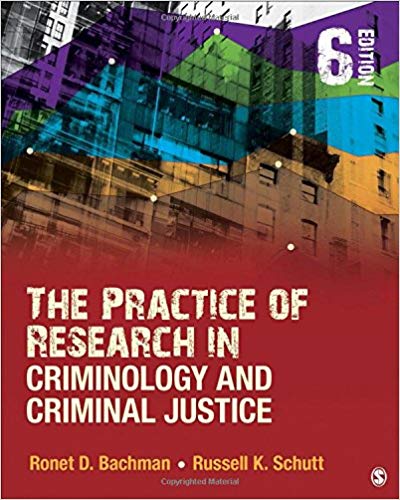Test Bank For The Practice of Research in Criminology And Criminal Justice 6th Edition By Ronet D. Bachman
Digital item No Waiting Time Instant DownloadISBN-10: 1506306810 ISBN-13: 978-1506306810
In Stock
Original price was: $55.00.$28.00Current price is: $28.00.
Test Bank For The Practice of Research in Criminology And Criminal Justice 6th Edition By Ronet D. Bachman
Bachman, The Practice of Research in Criminology and Criminal Justice 6th Edition
Chapter 2: The Process and Problems of Criminology Research
Test Bank
1. The four major stages in the research circle are:
a. Replication, data, theory, and hypothesis
b. Implementation, deduction, induction, and replication
c. Validation, theory, empiricism, and replication
*d. Theory, hypothesis, data, and empirical generalization
Section: Social Research Strategies
Bloom’s Taxonomy: Knowledge
2. In the course of a study, anomalous findings emerge. The researcher could do all of the following except:
*a. Immediately discard the results.
b. Use inductive reasoning to make sense of the unexpected findings.
c. Determine whether the unexpected findings are important.
d. Propose a new study in which deductive reasoning is used to compare the new findings with the original unexpected findings.
Section: Social Research Strategies
Bloom’s Taxonomy: Comprehension
3. According to deterrence theory, punishment for a deviant act reduces the likelihood that a person will repeat the act. A researcher decides that it must therefore be likely that tougher gun control laws would reduce the gun crimes of repeat offenders. This is an example of:
*a. Deductive reasoning
b. Sample generalizability
c. Inductive reasoning
d. Implementation
Section: Social Research Strategies
Bloom’s Taxonomy: Application
4. Which of the following is a hypothesis?
a. I agree with the death penalty.
b. The United States has the death penalty.
c. States with the death penalty will have lower murder rates.
d. The death penalty is immoral.
Section: Social Research Strategies
Bloom’s Taxonomy: Comprehension
5. If there is a negative relationship between social capital and crime, crime might be reduced by:
*a. Increasing social capital
b. Decreasing social capital
c. Using a deductive strategy
d. Not enough information provided
Section: Social Research Strategies
Bloom’s Taxonomy: Application
6. A positive relationship implies that:
a. Increases in the independent variable result in decreases in the dependent variable.
*b. Decreases in the independent variable result in decreases in the dependent variable.
c. Decreases in the independent variable result in increases in the dependent variable.
d. There is no relationship between the independent variable and the dependent variable.
Section: Social Research Strategies
Bloom’s Taxonomy: Comprehension
7. Assuming that social networks reduce criminal behavior, one plausible hypothesis would be that:
a. People who live in cities should be more likely to be victimized.
b. Cities should have larger social networks than rural areas.
c. People who live in cities should be more likely to commit crimes.
*d. People with few friends should be more likely to commit crimes.
Section: Social Research Strategies
Bloom’s Taxonomy: Application
8. An observer of street corner groups finds that more acts of vandalism are committed by same-sex groups than by mixed-sex groups. She speculates that the propensity to commit publicly deviant acts is a product of competition for recognition among peers of equal status. This speculation is an example of:
a. Overgeneralization
b. Deductive reasoning
c. Sample generalizability
*d. Inductive reasoning
Section: Social Research Strategies
Bloom’s Taxonomy: Application
9. A researcher conducts a study in which he measures the level of fear community residents have of being a victim of crime and the presence of police officers in a sample of urban neighborhoods. Based on findings, the researcher reports that there is no relation between fear of crime and police presence. This statement is:
*a. An empirical generalization
b. A valid deduction
c. A selective observation
d. An overgeneralization
Section: Social Research Strategies
Bloom’s Taxonomy: Application
10. When a researcher intends to document the length of a time a child plays video games (duration) but instead measures the number of times the child plays video games (frequency), this is an error of
*a. Measurement validity
b. Internal validity
c. External validity
d. Feasibility
Section: Social Research Standards
Bloom’s Taxonomy Application
Test Bank for “The Practice of Research in Criminology and Criminal Justice,” 6th Edition by Ronet D. Bachman
Overview:
- Title: The Practice of Research in Criminology and Criminal Justice
- Edition: 6th
- Author: Ronet D. Bachman
- Focus: This textbook provides a comprehensive guide to research methods in criminology and criminal justice, covering both qualitative and quantitative approaches.
Contents:
- Introduction to Research Methods: Overview of research in criminology and criminal justice.
- Research Design: Fundamentals of designing research studies, including hypothesis formulation and variable measurement.
- Qualitative Methods: Techniques such as interviews, observations, and content analysis.
- Quantitative Methods: Statistical techniques, survey research, and experimental designs.
- Data Analysis: Methods for analyzing and interpreting research data.
- Ethical Considerations: Ethical issues and guidelines in criminological research.
- Writing and Presenting Research: Best practices for reporting and disseminating research findings.
Features:
- Comprehensive Coverage: In-depth exploration of both qualitative and quantitative research methods.
- Real-world Examples: Case studies and examples from criminology and criminal justice.
- Review Questions: Exercises to reinforce learning and assess comprehension.
- Research Tools: Guidance on using various research tools and software.
Conclusion:
The test bank for “The Practice of Research in Criminology and Criminal Justice” offers a valuable resource for students and educators. It provides a broad range of questions and exercises to evaluate understanding and application of research methods in criminology and criminal justice, facilitating a deeper grasp of the subject matter.


Reviews
There are no reviews yet.